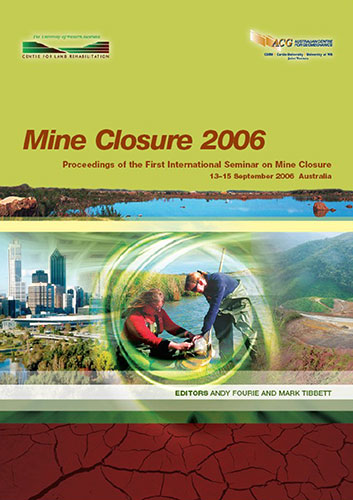The Effect of the Dispersive Nature of Tailings on Seedling Establishment and Survival

|
Authors: van Wyk, SJ; van Rensburg, L Paper is not available for download Contact Us |
DOI https://doi.org/10.36487/ACG_repo/605_32
Cite As:
van Wyk, SJ & van Rensburg, L 2006, 'The Effect of the Dispersive Nature of Tailings on Seedling Establishment and Survival', in AB Fourie & M Tibbett (eds), Mine Closure 2006: Proceedings of the First International Seminar on Mine Closure, Australian Centre for Geomechanics, Perth, pp. 391-403, https://doi.org/10.36487/ACG_repo/605_32
Abstract:
Tailings material is known to present a challenging growth environment as it presents several ecologically hostile characteristics. Although vegetation is initially established through active rehabilitation input, questions remain about spontaneous recolonisation potential of the area over time. The influence of soil physical properties and more specifically dispersivity, on soil-seed contact interface (safe sites) is still largely unknown for tailings dams which are rehabilitated without reshaping or a topsoil cover. Conventional grassing limits erosion only by 55% on gold tailings dams with slope gradients of more that 30°, which raises questions about the effectiveness and self-propagation of vegetation on tailings. The objectives of this study were to quantify the physical nature of gold tailings material in terms of its dispersivity and to report on the results of reconstructed soil profiles with improved dispersivity status. The relationship between dispersivity and the establishment of native grass seedlings were further investigated. This research adds to the sustainability debate of directly revegetated tailings dams and the degree to which reconstructed soil systems can sustain self-propagating and functioning ecosystems. It is therefore hypothesised that the inherent susceptibility of the tailings medium to erosion could substantially affect spontaneous vegetation establishment and will have an impact on seedling survival and inevitably successionary development if the dispersivity is not addressed.
References:
Blight, G.E. (1989) Erosion losses from the surfaces of gold tailings dams. Journal of the South African Institute for
Mining and Metallurgy 89, pp. 23–29.
Bradshaw, A.D. (1997) Restoration of mined lands – using natural processes. Ecological Engineering 8, pp. 255–269.
Bradshaw, A.D. and Chadwick, M.J. (1980) The restoration of land. University of California Press: Los Angeles. 317 p.
Day, P.R. (1965) Particle fractionation and particle size analysis. In Methods of soil analysis Part I. C.A. Black and
D.D. Evans (eds), pp. 545–567.
Dong, A., Chester A. and Simsiman, G.V. (1983) Soil dispersibility. Soil Science 136, pp. 202–208.
Dorren, D.I. and Blight, G.E. (1986) Erosion of the slopes of gold residue dams on the Transvaal Highveld –
Preliminary results. Journal of the South African Institute for Mining and Metallurgy 86, pp. 475–480.
Dvorak, J. and Novak, L. (eds) (1994) Soil conservation and Silviculture: Development in Soil Science 23. Elsevier,
London.
Department of Minerals and Energy Affairs South Africa (DME) (1995) Manual for the Construction, Operation,
Pollution Control, Restoration, Decommissioning and After-care of Gold Tailings Dams in South Africa.
Government Printer: Pretoria.
Evans, K.G. (2000) Methods for assessing mine site rehabilitation design for erosion impact. Australian Journal of Soil
Research 38, pp. 231–247.
Gray, D.H. and Leiser, A.T. (1982) Biotechnical slope protection and erosion control. Van Nostrand Reinhold
Company, New York.
Gauch, H.G. Jr. (1994) Multivariate analysis in community ecology. Cambridge University Press: New York, 298 p.
Handbook of Standard Soil Testing Methods for Advisory Purposes: Compiled by AGRICLASA (Agricultural
Laboratory Association of South Africa – Non Affiliated Soil Analysis Work Committee). (1990) Methods 1 –
35. Cape Town: Soil Science Society of South Africa Publisher.
Johnson, M.S., Cooke J.A. and Stevenson, J.K.W. (1994) Mining and its environmental impact. From: Issues in
environmental science and technology. London: Royal Society of Chemistry, pp. 31-47.
Mbagwu, J.S.C. and Bazzoffi, P. (1998) Soil characteristics related to resistance of breakdown of dry soil aggregates
by water-drops. Soil Tillage Research. 45, pp. 133–145.
Rorke, B.B. (2000) Soil erodibility and processes of water erosion on hillslope. Geomorphology 32, pp. 385– 415.
Sheridan, G.J., So, H.B., Loch, R.J., Pochnee, C. and Walker, C.M. (2000)(a) Use of laboratory-scale rill and interill
erodibility measurements for the prediction of hillslope-scale erosion on rehabilitated coal mine soils and
overburdens. Australian Journal of Soil Research. 38, pp. 285–297.
The Effect of the Dispersive Nature of Tailings on Seedling Establishment and Survival S.J. van Wyk, L. van Rensburg
402 Mine Closure 2006, Perth, Australia
Sheridan, G.J., So, H.B., Loch, R.J., Pochnee, C. and Walker, C.M. (2000)(b) Estimation of erosion model erodibility
parameters from media properties. Australian Journal of Soil Research. 38, pp. 265– 284.
Ter Braak, C.J.F. (1996) Unimodal models to relate species to environment. D.L.O. Agricultural Mathematics Group,
Wageningen. CANOCO Operational Manual. Microcomputer Power: Ithaca.
Van Rensburg, L., De Sousa, R.I. and Prinsloo, H.B. (1997) Field evaluation of methods for limiting water erosion on
the side slopes of tailings heaps. Applied Plant Science. 11, pp. 26–28.
Wang, G., Gertner, G., Liu, X. and Anderson, A. (2001) Uncertainty assessment of soil erodibility factor for revised
universal soil loss equation. Catena, Elsevier. 46, pp. 1–14.
Ecosystem Reconstruction and Pedogenesis
Mine Closure 2006, Perth, Australia 403
© Copyright 2024, Australian Centre for Geomechanics (ACG), The University of Western Australia. All rights reserved.
View copyright/legal information
Please direct any queries or error reports to repository-acg@uwa.edu.au
View copyright/legal information
Please direct any queries or error reports to repository-acg@uwa.edu.au